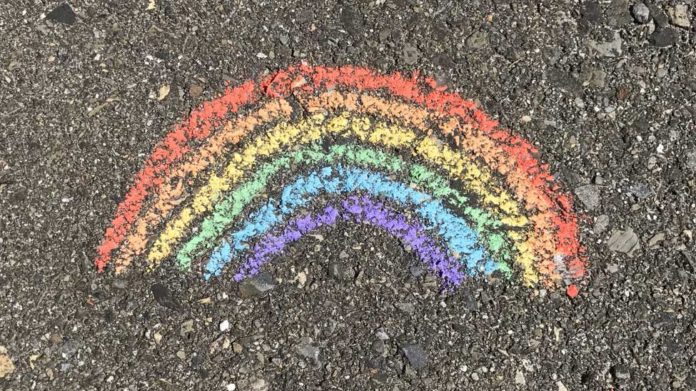Pride marches may be cancelled because of the pandemic, but there are still plenty of ways for LGBTQ families to mark the occasion and teach our children about its meaning and history.
Connect with other LGBTQ families online. Family Equality has created “The Neighborhood: A Virtual Hub for LGBTQ Families,” and is hosting a plethora of events for parents, prospective parents, and children. Many other regional LGBTQ family organizations and LGBTQ centers are also hosting family events online.
Attend a virtual Pride near or far. Pride organizations in many locations are hosting virtual events. Why not attend not only the Pride nearest you, but also one in another city or country? And don’t miss the online Global Pride (globalpride2020.org) on Saturday, June 27, 2020, with live-streamed musical performances, speeches, and messages from world leaders and human rights activists. Global Pride is organized by Pride groups around the world
Have a Pride scavenger hunt. How many sets of items in each of the colors of the rainbow can you find in your home? A set of rainbow crayons? Probably pretty easy. What about socks? (I’d lose that challenge–mine are mostly black or white, though I know some folks have fancier feet.) Or t-shirts? Candies? Can you add in the colors of other Pride identity flags?
Decorate inside and out. Use the items you’ve collected above to create a visual expression of Pride. Throughout the pandemic, I’ve been moved by the number of people who have put out signs celebrating graduations, birthdays, and other events. Decking out our houses and apartments for Pride seems only fitting. A chalk rainbow in the driveway? A flag in the window? Rainbow socks on a clothesline? If you need or want to be more private, go for fridge decorations, streamers in your hallway, or other interior touches.
Cook for Pride. Rainbow sprinkles on cupcakes is the easy (but delicious) way to go. A rainbow-hued fruit or vegetable salad is a tad healthier. Be creative, though: what about an LGBTQ buffet: Lettuce, Guacamole, Beans, Tomatoes, and Quesadillas?
Read about the Pride flag. You can make any of the above activities into an educational experience for young kids by also reading one of the many books on the Pride flag. For the very youngest, try Robin Stevenson’s board book “Pride Colors”, “Rainbow: A First Book of Pride” by Michael Genhart, or two from Little Bee Books: “Our Rainbow” and “Kevin Keller’s Favorite Colors.” Elementary school kids might enjoy “Pride: The Story of Harvey Milk and the Rainbow Flag,” by Rob Sanders, or “Sewing the Rainbow: A Story About Gilbert Baker,” by Gayle E. Pitman.
Read a new children’s book about Pride. In addition to the above books about the colors of Pride, try the brand-new “Pride 1 2 3,” by Michael Joosten, a counting board book set at a Pride celebration, or “The Hips on the Drag Queen Go Swish, Swish, Swish,” by Lil Miss Hot Mess (a founding member of Drag Queen Story Hour). It’s not explicitly set at a Pride event, but it captures a similar feeling as a bevy of queens with diverse skin tones and hair colors dance and pose “all through the town.”
For middle-grade readers and up, “Pride: The Celebration and the Struggle,” also by Robin Stevenson, is a newly updated and expanded edition of her Stonewall Book Award-winning book on Pride and the LGBTQ-rights movement. It blends the history of the event with a broader look at the struggle for LGBTQ equality around the world. And the new “Rainbow Revolutionaries: Fifty LGBTQ+ People Who Made History,” by Sarah Prager offers short profiles of LGBTQ people who have had an impact on the world in a variety of times and places. For more Pride books for kids of all ages, see my longer list at mombian.com.
Recommit to taking action towards social justice. As we begin Pride this year, the blight of racism continues to rip at our country’s soul. It will do us well to remember that Pride was born from protest and resistance. While we pull out the rainbows to celebrate our progress, then, let us also remember how far there is to go for the LGBTQ community, for other marginalized groups, and for those who reside in both. Let us teach our children, in age-appropriate ways, about the injustices that led to Pride and those that still exist for LGBTQ people, people of color, and others. And let us teach our children about people who fought and are still fighting to dismantle systems of oppression.
I can only offer my own perspective, which is that of a White lesbian, but I know I must keep working for racial justice by being mindful of my own words and actions and by taking action against systemic injustice. As a parent, too, I know it is important to model this for my White son. There are a growing number of anti-racism resources for White parents online; three to start with are EmbraceRace (embracerace.org), Raising Race-Conscious Children (raceconscious.org), and Teaching Tolerance (tolerance.org), which covers not only race but also other identities. It’s a valuable resource for teachers as well as parents.
May Pride be a time for us not only to celebrate how far we’ve come, but also to support each other during the difficult present and through the journey ahead.
Dana Rudolph is the founder and publisher of Mombian (mombian.com), a GLAAD Media Award-winning blog and resource directory for LGBTQ parents.

